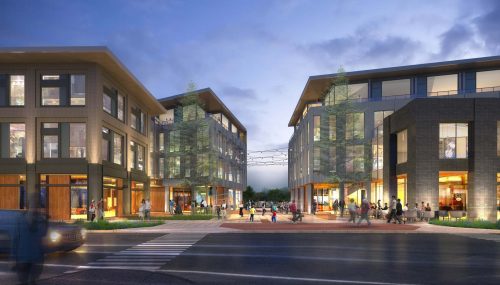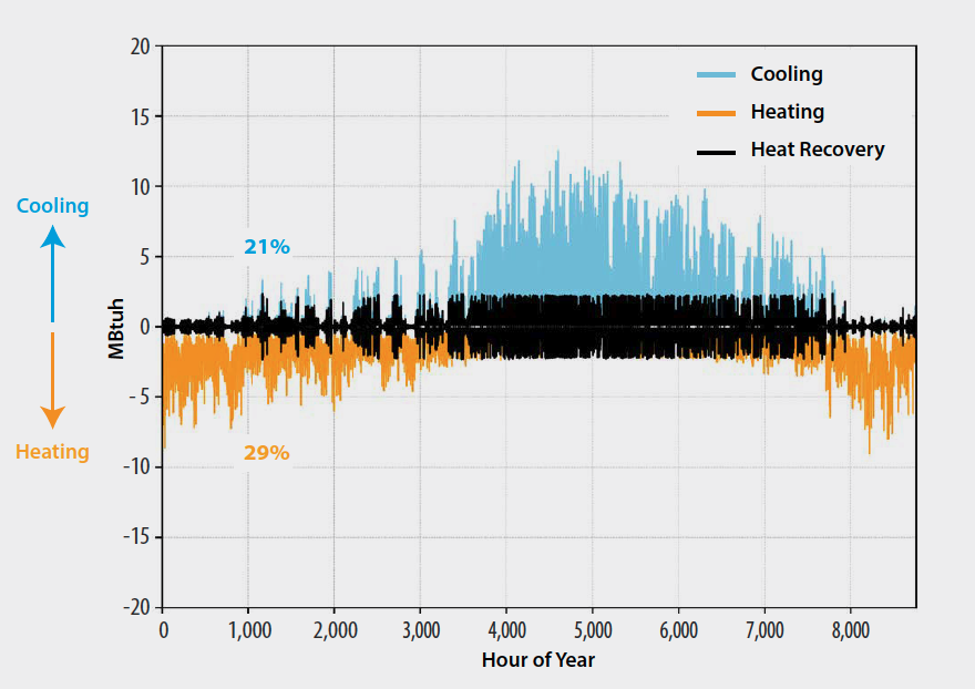Photo courtesy of Morgan Creek Ventures

Combating Climate Change through High-Performance Districts
If we are going to keep global temperature rise below 1.5°C, we need to fix our buildings. They are the largest end-users of energy, generating nearly 40 percent of annual global greenhouse gas emissions. However, addressing energy efficiency and renewable energy one building at a time will not be enough. To make real change, we must also work at a district level.
In 2016, Rocky Mountain Institute (RMI) worked with the National Renewable Energy Laboratory (NREL) and US Department of Energy (DOE) to launch the Zero Energy District Accelerator. The goal of the Accelerator was to share best practices and provide technical support to groups wanting to implement high-performance building strategies on a district scale. The three-year long process led to many emerging high-performance districts, as well as the recently released report, A Guide to Energy Master Planning of High-Performance Districts and Communities.
The guide, coauthored by NREL, RMI, US DOE, Integral Group, and BluePoint Planning, illustrates an iterative process of building support for, planning, and implementing high-performance districts. These districts take advantage of the synergies available when energy consumption and production are considered on a district scale rather than a single building scale. This is an important strategy to reduce emissions, increase energy security, and improve resilience.
What Is a High-Performance District?
A high-performance district is a multi-building project in which the buildings as well as the district as a whole integrate and optimize their energy attributes on a life-cycle basis. This includes energy conservation and efficiency, heating and cooling systems, and renewable energy systems. A high-performance district can have a goal of improving its energy performance, achieving net-zero energy, becoming carbon neutral, or even becoming an energy-positive district (generating more clean energy than it consumes).
High-performance districts offer many benefits to both owners and occupants. These include cost reductions from purchasing economies of scale, higher district-wide efficiency due to building and energy load diversity, improved indoor conditions due to air quality and natural lighting, higher marketability, and resilience.
Creating an Energy and Financial Master Plan
One of the most important aspects of creating a successful high-performance district is creating robust energy and financial master plans. Energy master plans are critical to ensuring that the district’s energy efficiency and renewable energy goals are met, while also balancing thermal loads across the project. In order to achieve these balances, the energy master plan must thoughtfully plan investments in supporting infrastructure, and consider the complexities of aggregating electrical and thermal loads.
This energy balancing is a way to cost-effectively optimize district energy use. Energy systems in a high-performance district may include distributed renewable energy systems, a microgrid that integrates renewables with battery storage and district-level control, and district thermal (heating and cooling) energy systems.
A fully optimized district energy master plan could ensure that renewable energy and energy storage systems operate to provide the most financial and environmental benefits to the entire district (rather than individual buildings) by beneficially exchanging energy with the grid. Depending on the project’s climate and the building use types, this type of a plan could also rely on energy synergies to exchange heat between buildings rather than heat and cool separate buildings simultaneously (see District Heating and Cooling below).
The viability of any high-performance district relies on a solid financial plan that considers the life-cycle costs of each component of the high-performance district. Typically, high-performance districts require higher up-front capital investments in energy efficiency and district-level energy infrastructure that will yield substantial long-term operational cost savings in the form of reduced energy use, operations and maintenance costs, and equipment replacement expenses.
RMI’s business model for developing high-performance districts highlights one specific way to provide a financial plan for high-performance districts that is attractive to the district developer, parcel developer, and tenants. The model creates a profitable business for an integrated energy services provider and benefits the local electric grid and neighboring community.
District Heating and Cooling
Heating and cooling buildings on a district level provides great benefits including higher efficiency, lower costs, and more reliable and resilient energy. Instead of each building having its own heating and cooling sources, a district energy system exchanges heat between a central plant and a group of buildings.
A key advantage of a district thermal approach is that the diversity of thermal loads across buildings (e.g., time of day, days of week, months of year) can lead to additional savings by creating opportunities for waste heat recovery and energy sharing. One way to do this is to include diverse building types. For example, residential and commercial buildings are often used at different times of the day, and thus can have complementary heating and cooling load profiles. They may even benefit from waste heat produced in other building types with higher energy densities (e.g., high-rise office buildings or manufacturing plants).

Although district thermal systems have been around for more than a century, they have come a long way since the steam systems of the late 1800s. We now have systems that are much more efficient and that can work in extreme temperatures. Two examples of innovative district thermal systems to arise out of the Accelerator are the National Western Center and Cornell Tech.
Capturing Heat from Sewage—National Western Center
One of the most innovative and efficient ways to provide heating and cooling is through wastewater, a consistent source of heat throughout the year. This is what’s happening at the National Western Center, located on the historic grounds of the Denver Union Stock Yard Company, which currently hosts the annual National Western Stock Show. The City and County of Denver, the National Western Center Authority, the Western Stock Show Association, and Colorado State University all came together to redevelop the site. It will soon be transformed into a 250-acre multipurpose zero-energy campus.
Along with adding on-site renewable energy systems to provide 100 percent of the site’s electricity, the campus will include a district energy system that pulls thermal energy from an underground sewer pipeline. This 3.8 megawatt system will be the largest sewer heat recovery system in North America. In the long run, this system will have a comparable cost to traditional natural gas systems, while saving an estimated 2,600 tons of CO2 emissions per year and meeting nearly 90 percent of campus heating and cooling loads.
Ground Source Heat Pumps—Cornell Tech
The Cornell Tech campus, located on Roosevelt Island in New York City, is designed to encourage interactions between industry and academia. The 12.4-acre campus includes academic buildings, offices, a hotel, a residential tower, and conferencing and assembly areas, with space remaining to accommodate future program requirements. The main academic building, the Bloomberg Center, is a zero-energy building that is heated and cooled by a ground source heat pump system.

The system includes 80 boreholes, each 400 feet deep, drilled below the main campus public open space. These boreholes reach water-filled fissures in the local bedrock, where the groundwater movement helps heat exchangers extract and reject heat to heat and cool the building. It’s the first time that a groundwater pumping system has been applied to a closed-loop geothermal system in the United States. This system, in conjunction with solar photovoltaics and energy efficiency building design, is expected to save up to 500 tons of carbon dioxide emissions per year.
Taking Building Efficiency to the Next Level
The benefits of building energy efficiency are well understood and have been integrated into many local and international building codes. In addition, renewable energy systems are becoming more common place as prices drop and environmental awareness grows. Optimizing energy efficiency and renewable energy generation across a large development is a paradigm shift for most real estate developers, owners, and professionals. However, this is the next step we must take in order to address the climate crisis.
A Guide to Energy Master Planning of High-Performance Districts and Communities can help architects, planners, engineers, local government agencies, and real estate developers take advantage of the synergies available when energy consumption and production are considered at a district level rather than one building at a time.

